#Cabalgata de Reyes
Text
Magic kings's riding began in France
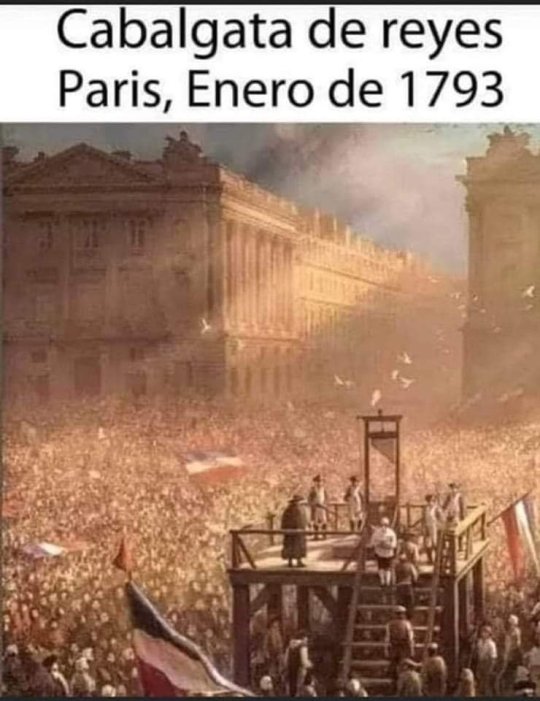
#imitación al arte#life imitates art#french revolution#guillotine#cabalgata de reyes#reyes magos#wise men
4 notes
·
View notes
Text
Enfado de los hosteleros porque el Ayuntamiento les prohibió sacar terrazas durante la Cabalgata de Reyes
Enfado de los hosteleros porque el Ayuntamiento les prohibió sacar terrazas durante la Cabalgata de Reyes
El Partido Popular de San Vicente del Raspeig se solidariza con los hosteleros afectados en la Avenidad de la Libertad en la tarde del 5 de enero, al no poder instalar sus terrazas durante la Cabalgata de Reyes, lo que ocasionó que algunos de ellos se vieran abocados a cerrar sus establecimientos en una jornada de máxima afluencia de público.
El candidato a la Alcaldía del PP, Pachi Pascual, ha…

View On WordPress
0 notes
Text
Más de 80.000 getafenses disfrutaron de la Cabalgata de Reyes
#GETAFE Más de 80.000 getafenses disfrutaron de la Cabalgata de Reyes ¡GETAFE RADIO te lo cuenta!

View On WordPress
0 notes
Text
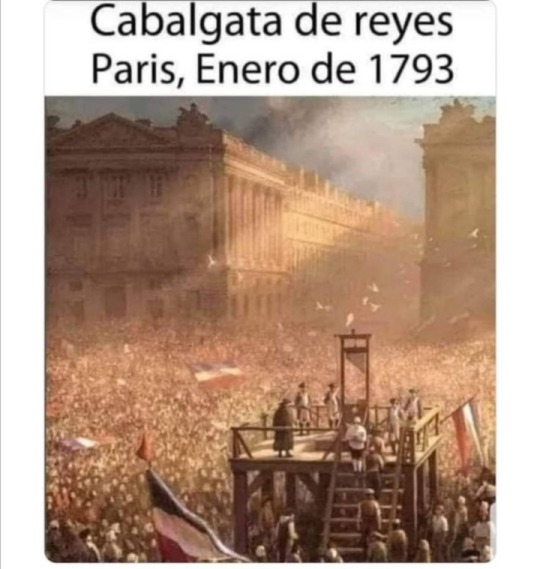
0 notes
Text
Estresado terminó MELCHOR el día de la cabalgata ...
3 notes
·
View notes
Text
i love the holiday season but not because i am religious or love the santa claus mythology and iconography, but because it is full of little rituals and ceremonies in a very short period of time that make me feel so alive and remind me of what it means to be human
#i started thinking about the cabalgata de reyes and how i want to go watch it every year in my life#also everytime nye approaches and i start thinking about everyone starting the year at the same time and at least in spain in the same way#i start feeling so amazed at the world and at time and at humans and everything#it's so fucking incredible
7 notes
·
View notes
Text
La magia de la Navidad llega a Guadarrama con un programa de actividades para toda la familia
La magia de la Navidad llega a Guadarrama con un programa de actividades para toda la familia
El alumbrado navideño se inaugurará a las 20:30 horas del viernes 2 de diciembre
La iluminación y decoración navideña, los talleres, mercados, conciertos, juegos, etc… vuelven a formar parte de la programación de Navidad que el Ayuntamiento de Guadarrama pondrá en marcha el próximo 1 de diciembre con la apertura del primer mercado de Navidad en la Plaza Mayor.
Un programa que ha sido elaborado…

View On WordPress
#duendes#elfos#familias guadarrameñas#Gran Cabalgata de Reyes#Guadarrama#hadas#juegos#La magia de la Navidad#Majestades los Reyes Magos de Oriente#Pide un deseo es Navidad
0 notes
Text
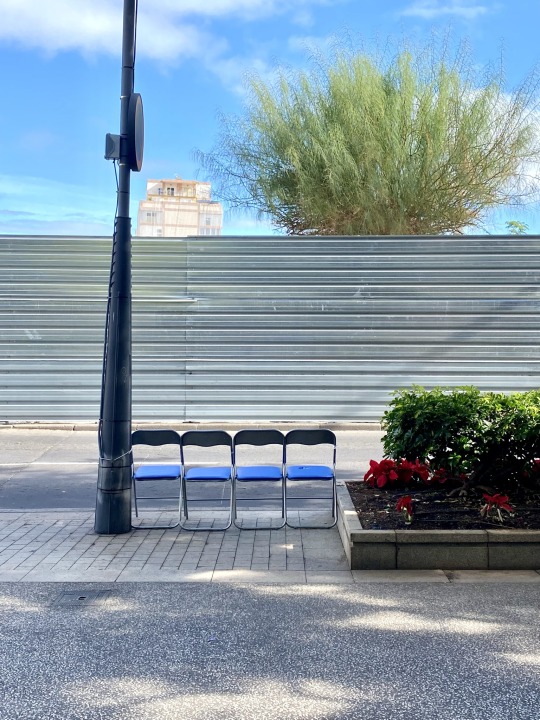
5 de enero de 2024.
Al otro lado de la farola.
Esperando por la cabalgata de los Reyes Magos.
#carmen nuñez#woman photographer on tumblr#canary islands#iphone#photographers on tumblr#three wise men#parade#january#2024
50 notes
·
View notes
Note
what christmas tradition would you most like to do with jure?
I didn't know if you meant Christmas as the holiday in general or just the Christmas day, so I did the first one :)
I couldn't think of any special tradition so I went with some more classic ones here (but maybe people outside Spain don't do them and they think they're interesting idk hhzisnsjx)
The New Year's Eve Chimes (is that the word for "campanadas"?)
Basically, on New Year's Eve, when the clock is about to strike 12am, we have the tradition of eating 12 grapes (one for each of the bells, 1 second apart each), which represent the 12 months of the year and it is said that it'll give us luck in the new year
It's really funny to see people trying to swallow 12 grapes in 12 seconds and trying not to choke on them (just saying lol), so I think it would be fun to see him try it
It may seem easy if you've never tried it, but trust me, many people can't do it (I always do tho 😌)
See the Three Wise Men Parade
On the afternoon of January 5th we have these "cabalgatas" (something similar to a parade but not quite) with several floats that go around the town/city. In these floats there are people dressed as the Three Wise Men (+ many children and people helping of course) and basically what they do is throw candy and toys/balls/small things so people can catch them
I'd love to go out with him to see the floats and try to get lots of candy. We could use my grandpa's old tactic of taking an open umbrella and turning it upside down so that all the candy falls inside (leaving some for the kids obviously). Would they call us childish? Probably. Would either of us care? Nope

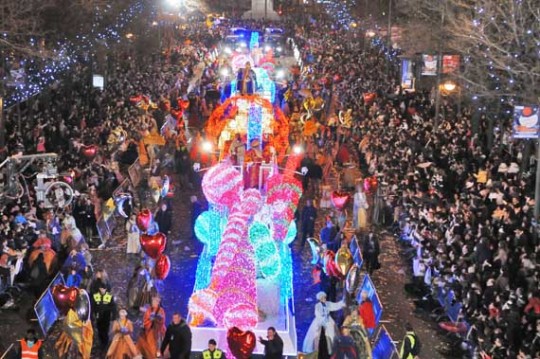
I wanted to show some pics but this is all I could find (they're usually so beautiful from up close but you can't really see them well here)
Eat the "Roscón de Reyes"
On January 6th, we eat the "roscón de reyes", which usually looks something like this:

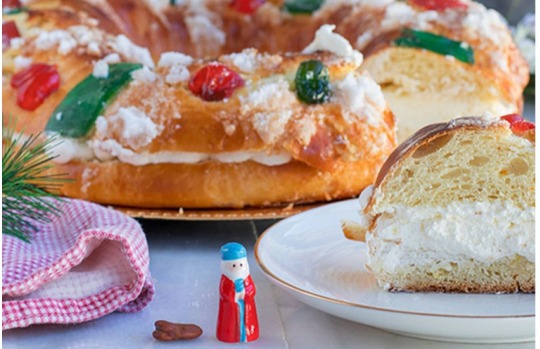
The interesting thing is that inside the cream there are 2 things hidden: a little figurine and a bean (as you can see in the photo). The person who finds the figurine in their piece is crowned "king" and gets to keep the plastic crown. On the other hand, the person who finds the bean must pay for the roscón.
Just imagine Jure's face if he finds the figurine and gets to put on the crown 🥹. And if not, at least he could eat the roscón, we all know he's got a sweet tooth
Bonus: Bake cookies and watch Christmas movies
It's not really something I do every year, so I wouldn't consider it a tradition, but last year my friends and I met up at a friend's house to make cookies and we had so much fun!
You know, being in our pajamas, making cookie dough together while telling stories and laughing and singing christmas songs, but not without throwing a little flour at each other (and maybe some chocolate chips too), making shapes for the cookies and decorating them however we want. I would make one in the shape of a kitty for him as a surprise :3
Then we can play some board games by the fireplace while we wait for the cookies to cool, and finally, we can watch a Christmas movie (or any kind of movie, I don't care) while we cuddle under a warm blanket and eat cookies :)
#sorry it took ages to answer but thank you for the ask this is so sweet 🥹#you get a long answer for waiting so long nonny <3#and now i'm curious because i saw you (i guess it was you) asked more people#did i get the ask about jure randomly or do I have the reputation of being a jure girlie?#if it's the last one i'm proud of my work with the jure propaganda :)#joker out#jure maček#ask#christmas asks#mine#maca speaks
13 notes
·
View notes
Text
José Ángel Ponsoda retransmite en 12TV la Cabalgata de Reyes Magos de Alicante
José Ángel Ponsoda retransmite en 12TV la Cabalgata de Reyes Magos de Alicante
El veterano y popular comunicador alicantino José Ángel Ponsoda será el encargado este año de narrar la retransmisión en directo de la Cabalgata de Reyes Magos en 12TV este 5 de enero de 2023.
El veterano comunicador alicantino especializado en tradiciones, fiesta y cultura local narrará en directo el espectáculo preparado para este año desde las calles de Alicante
Ponsoda está especializado en…
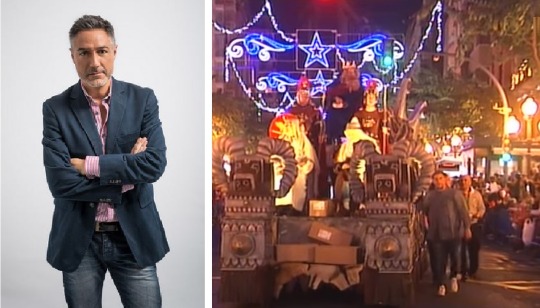
View On WordPress
0 notes
Video
youtube
Cabalgata de Reyes Magos, Mérida 2020
3 notes
·
View notes
Text
Tiempo de amar, dar, perdonar... 💚💚💚💚💚💚💚💚💚💚💚💚💚💚💚💚💚💚💚💚

Tiempo de amar, dar, perdonar,,,
💚💚💚💚💚💚💚💚💚💚💚💚💚💚💚💚💚💚💚💚
💚💚💚💚💚💚💚💚💚💚💚💚💚💚💚💚💚💚💚💚
“El amor es un poema enteramente personal. La mayor tristeza es pasarse la vida sin amar. No vivamos esperando el amor de los demás. Seamos generosos. Porque para poder recibir, es necesario primero saber dar”
Descubre placer en lo elemental, comer, respirar, caminar, saborear, tocar, ver, amar. Cuando el poder del amor supere el amor al poder el mundo conocerá la paz.
El verdadero amor deja que la otra persona sea lo que realmente es. El amor… rodea a cada ser y se extiende lentamente para abrazar todo lo que será.”
El amor no posee ni es poseído, porque el amor es suficiente para amar.”
💚💚💚💚💚💚💚💚💚💚💚💚💚💚💚💚💚💚💚💚
Cuando llegan estas fechas, nuestras neuronas más frescas, recuerdan muchísimas cosas.
Cuando era una niña, todavía no se había importado en España, todo lo que conlleva Papa Noel; nuestra tradición eran los Reyes Magos, y respetando a todo el mundo, no lo considero ninguna clase de mal; ese tipo de tradiciones, creo que son totalmente inocentes e inspiradas en la Escritura.
Ni sé que años podría tener, pero era lo suficientemente pequeña como para creer totalmente en los Reyes Magos; aquello de …”Acuéstate y duerme rápido… Mira que si te ven los reyes….”
Sí recuerdo una especie de pesadilla en la que, cuanto mas quería dormir, más me desvelaba, hasta que el sueño me venció y sólo recuerdo despertarme a, ni sé que hora empapada en sudor, habiendo soñado con que que los reyes me veían.
Es que lo recuerdo al dedillo…. El momento, la marina de mi ciudad, sentía como los magos me podían adivinar y, el terrible miedo a que no me dejaran ningún regalo.
Fueron pasando los años, y también recuerdo perfectamente una tarde en la que mi madre estaba planchando, mientras yo estaba a su lado tratando de aprender, y pensando en algo que me preocupaba mucho.
Fue entonces cuando yo comencé la conversación:
¡Mamá! Es que no entiendo nada, hay cosas que ni entiendo ni me encajan…
-¿Cómo cuales? Me respondió ella.
-¿Cómo puede ser que los Reyes Magos que fueron a ver al niñito Jesús hace tantísimos años, sigan existiendo? a mí no me encaja nada de esto, ¿me lo puedes explicar?
En aquel instante, se me cayeron al suelo todos mis sueños de niña pequeña, mis cartas a los reyes, mi visita con mi abuelo y recorrido con la cabalgata….. pero mi madre fue honesta conmigo y me dijo toda la verdad.
Creo que las personas pasamos por distintas fases en estas épocas del año.
Primero nos morimos con la ilusión y lo disfrutamos al mil por mil, a medida que van pasando los años, nos parece un tanto pesado todo; de manera especial cuando pasamos por la adolescencia.
Cuando va pasando el tiempo y tenemos a nuestros propios hijos, volvemos a vivirlo con una nueva ilusión, por y con ellos. Luego llegan épocas que duelen demasiado cuando comienzan a faltar seres queridos irreemplazables en nuestras mesas, son años muy duros que no se olvidan nunca….
Pero luego comienzan llegar nuevos miembros chiquitos a la familia, y nuestra ilusión se renueva otra vez.
En medio de todo esto, existen cosas que mucha gente no entiende. Para empezar, el verdadero significado de la Navidad… Dios hecho hombre viene al mundo a nacer del modo mas humilde que pueda existir, nacido para morir, para morir por nosotros y lograr así nuestra salvación.
Eso es Navidad y punto, Nosotros lo recordamos con agradecimiento, celebramos y adoramos. Pero todo esto no termina ahí, Creo que estas fechas son muy especiales para amar, dar, y perdonar.
Sin amor, absolutamente todo carece de sentido, podemos tener y compartir lo mejor del mundo, simplemente será muy bonito, pero un puro oropel, un metal que resuena y un címbalo que retiñe.
Sin amor por los demás, por el que sufre, por el que necesita…. Todo carecerá del mas mínimo valor.
Luego viene el dar. ¡Si! El dar a aquellos que amamos, el dar a aquellos que nos dan y podemos corresponder es muy bonito. Pero… ¿Nos acordamos de aquellos que no tienen?
Es fácil hacer un paquetito, enviar un donativo y cosas por el estilo. Pero ¿qué del hacer un hueco en nuestra mesa a aquel que, tal vez se siente terriblemente sólo por que es su inmigrante que se siente sin hogar, familia o dinero? . Prefiero dejarlo ahí.
Y luego viene algo muy grande, me estoy refiriendo al tema del perdón. ¿De que me vale amar, dar, comprender el verdadero significado de la Navidad, sin poder perdonar, incluso las más grandes ofensas que alguien me haya podido hacer?
Sinceramente, de absolutamente nada. Conocemos al dedillo el Padre nuestro, la oración modelo, ¿alguien me puede explicar aquello de….. ¡Perdona nuestras ofensas así como nosotros perdonamos a nuestros deudores? Creo que acabo de hacer una pregunta totalmente retórica. Todos lo entendemos a la perfección.
Para terminar esta reflexión, supongo que no he dicho nada nuevo; pero sentía que debía refrescar la memoria, a mi misma en carne propia, y a quien haya leído este escrito.
Ya que el Rey de reyes nos amó, se dio y se entrego hasta la muerte y muerte de cruz, saldando allí todas nuestras cuentas pendientes y borrando con Su sangre preciosa todos nuestros pecados, ¿qué nos queda a nosotros?….
Simplemente… AMAR, DAR Y PERDONAR…
💚💚💚💚💚💚💚💚💚💚💚💚💚💚💚💚💚💚💚💚
En Aquel que nos amó primero...
Beatriz Garrido 💚💚💚💚💚💚💚💚💚💚💚💚
2 notes
·
View notes
Text
i can't believe my 19 yo sister is hooking me up with a job after 3 years using every goddamn job board ever and not finding one
3 notes
·
View notes
Text
Three Kings Parade 2023 | Christmas | Barcelona website
Mai programajánlónk. Gyertek!
Ps: Hát.... nézzük a felvonulást. Vicces rövidnadrágban meg hawaii ingben grasszálni napközben Barcelonaban, de napnyugta után órákig ácsorogni 10 fokban....




7 notes
·
View notes
Text
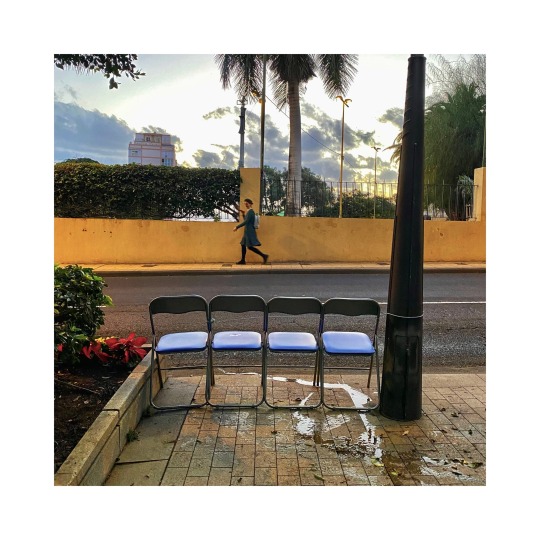
7:46 am. Ready for the Three Kings parade. 😄
7:46 am. Listos para ver la cabalgata de los Reyes Magos
#carmen nuñez#woman photographer on tumblr#santa cruz de tenerife#the three kings#the wise men parade#parade#iphone#original work#original photography blog#photographers on tumblr
59 notes
·
View notes
Text
Cold winter: Los Reyes Magos
LOS REYES MAGOS
Category: Spanish folklore / Christmas season / Biblical lore
In Spain, children don’t wait eagerly for Christmas. Christmas is a big holiday for adults, not for them! They don’t get any presents on Christmas… No, they only get presents during the other big holiday of the winter season. Not Christmas, not New Year… But the Epiphany, also known as “El dia de los Reyes” (The day of the Kings). And they don’t get their presents from any Santa or Saint Nicholas – but from Los Reyes Magos, The King-Magi – or those that the English like to call “The Three Wise Men”.
Everybody knows the story… After the birth of Jesus in Bethlehem, three “wise men” (not actually but more about that later) came from the east to Judea, and asked king Herod to see the child that had been born “king of the Jews”, explaining that they knew he was here for they followed his “star” in the night sky, and came to pay homage. King Herod, who had tried to kill baby Jesus before, then sent the three wise men to search the baby on their own, but told them to come return to him afterward so he could too “pay homage” to the “king of the Jews”. Following the rising star, the three wise men finally found where baby Jesus was – and they all kneeled before him and his family, offering three gifts: gold, frankincense and myrrh. But a dream warned them not to return to Herod or inform him about the child’s location, so after they paid their homage they “returned to their country by another path”.
In Spain, the Epiphany is a grand celebration of the Magi : they are the ones supposed to bring gifts to children on the night of the Epiphany (and the children notably have to send letters to the three Kings to explain their desires, just like with Santa). Each Epiphany Day great and colorful parades are organized throughout the town (called the cabalgatas de los reyes mmagos or cavalcades of the Magi), welcoming the three Kings as they throw candies and goodies at the audience: Melchior from Europe (or Arabia depending on the tradition), Gaspar from Asia, and Balthazar from Africa. Coming from the East while riding camels, they then proceed during the night (or the eve’s night) to visit each household, leaving gifts for the children in their polished shoes. In exchange, the children leave some food and drinks for both the Kings and their camels – sweet wine, fruits, milk, dried grass and hay… If the child was good, they will receive a gift – but if the child was bad, they will receive coal (though, just like with the Befana’s tradition, the coal was promptly replaced by a form of black candy called “sweet coal”). There is also a specific cake for the Epiphany, called the “Roscon de Reyes” (accents not included), a brioche-like cake with orange blossom water for the taste. It is in the shape of a circle, to mimic a crown, and has as “jewels” candied or crystalized fruits. Usually filled with cream (though some are “plain” without filling, while others prefer chocolate cream or whipped cream), it also contains a small figurine shaped like one of the Reyes Magos, and dried bean. Whoever gets the slice with the figurine is crowned the “king” or “queen” for the day, and is ensured to have good luck for the year ; however the one that gets the bean will have to pay for the cake.
I want to return on what I said before… the fact that the three Kings come from three different continents. It is a tradition that exists outside of Spain, and for quite a long time. In fact it was a tradition started by medieval art, and then reused by Renaissance art heavily – before being picked up by folk traditions such as the Epiphany holidays. This tradition insists on having the three Magi correspond to the three parts of the world (as they were known in the Middle-Ages, and before the discovery of America, “the fourth continent”). Hence the separation above and the idea that the Three Kings were white, oriental and black – to represent how the powerful kings of the entire world came kneeling down in front of Jesus. But this tradition tends to overlap with another one… another habit that rather has the three Kings represent the three ages of men, one being old, the other middle-age, and the last young. Sometimes the two depictions are separate, other times they overlap – and the last case is fascinating because the choice of superposition is not innocent. In this overlap, Melchior the European will be depicted as an old man, because in medieval (and Renaissance) ideas, Europe was the “old civilization” and the “father” of all things. Meanwhile, Balthazar of Africa will be depicted as a young man, because in medieval and Renaissance mindsets Africa was a “child” continent with barely any civilization (and if you told them Africa had a much older history than Europe they would have laughed in your face). Gaspar the Asian is usually the middle-aged one.
But this tradition of the “symbolism of three” actually comes from art and folk traditions – I want to insist on this. It is not a religious tradition, because for religious authorities and the “actual” Christian culture (pushing aside all local traditions), the three wise men don’t come from just anywhere in the world. They come from the East, the text is pretty clear.
But before that, let’s take a look at the actual title of these guys… People call them the “three wise men”. Wrong translation. Or an oversimplified one. People call them the “Three Kings” and the “Three Magi”, and this is half-right, because they are “king-magi”. The “king” part is pretty obvious, but the “Magi” part might be more obscure to people today. “magi” is the plural of “magus” which, yes, is the origin of “mage” and with time came to mean “sorcerer” (the New Testament several times use the term “magi” to designate sorcerer and male witches, like Simon the Mage or Elymas). But here, “magus” has to be understood in its original sense: the Greek transliteration of the Old Persian “magus”, which is actually a term designating the priesthood of Zoroastrianism. The Zoroastrian priests were most notably renowned as astronomers, because their study and religious practices demanded that they knew and observed the starts and the constellations (hence the whole “we followed a star to find the babe”). And, due to being both priests and astronomers, the “magi” came to be seen and perceived as men dabbling in the “occult” or men of many high and intellectual crafts – hence the evolution into “wise men” and “sorcerers”, and how from “priesthood-rulership” the “three magi kings” turned into “knowledgeable kings dabbling into astronomy”. That, coupled with them “coming from the East”, came to people identifying them as kings from the Parthian Empire, which stretches from Syria to India, and had Zoroastrianism as a dominant religion.
The most well-known and agreed “origins” of the three “scholar-kings” in religious traditions has a given set of countries: Persia for Melchior; India for Caspar (or Gaspar or Jaspar), Arabia for Balthasar (or Balthazar), though he is sometimes rather given Ethiopia as a kingdom. But there is another one, which overlaps with the “three ages of man” depictions, that rather claims that Caspar was the old one and “king of Tarsus” (a land on the southern coasts of today’s Turkey), Melchior was the middle-aged ruler of Arabia, and Balthazar the young man coming from Saba (today’s northern Yemen).
Similarly, which magus gave which gift to baby Jesus is a big subject of debates – but everyone agrees on the fact that there were three gifts. Gold, frankincense and myrrh. The meaning of these gifts has also been heavily debated. Some people invoke that, very simply, it just are very valuable, very rare gifts, precious enough to be worthy of a king – myrrh being a precious body oil, frankincense a type of perfume, and gold being gold. These people hold that the gifts should merely be interpreted as “gifts for a newborn king”. But another group rather wants to see in those gifts three symbols reflecting Jesus’ life, and his nature as the Christ. Indeed, “gold” would mean a form of material power and wealth, and reflect an earthly kingship, while frankincense (which is used as incense) would reflect a type of worship and prayers, and mean a divine nature (as Jesus is the “son of god”). As for the myrrh… it was used as an embalming oil, and would represent death – either the mortal nature of this son of God, or his foretold death at the cross, a crucifixion needed to redeem all of humanity. This is notably associated with a famous sentence “Gold, as to a king ; myrrh, as to one who was mortal ; and incense, as to a God”. (A “softer” interpretation in this sense rather invokes gold as symbolizing a great, pure virtue ; frankincense as representing a strong faith and solid prayers, while myrrh is here to symbolize the suffering of a mortal life).
- - - - - -
Unfortunately, in modern urban areas of Spain, the tradition of the Reyes Magos as gift-givers tends to be replaced by the much more well-known and widespread Santa Claus.
But I want to add one thing about the “Magi-Kings”. I talked about the folkloric and artistic tradition. I talked about the religious tradition. However, what about the original text? It is fascinating to look at the actual text that speaks of them, only one of the four Gospels, Matthew’s Gospel. Because… well most of what we “know” or believe about this trio isn’t in there.
For example yes, the three wise men come from the east… But the text never specifies that they were three. This idea came from the fact the magi came bearing three gifts – but nowhere in the text are they said to be three. (In fact early traditions and depictions spoke of two, four of five magi). Similarly, the names “Gaspar, Balthazar and Melchior” aren’t in the New Testament. They were “found” or “invented” later, in posterior texts. In fact some local churches give them different names: the Ethiopian Church, one of the oldest branches of Christianity in the world, calls them “Hor”, “Karsudan” and “Basanater”. And let’s tackle another myth: “reyes” magos ; “rois” mages ; “king” magi… The text never specifies that they were kings. The text only speaks of “magi”. Nowhere are they king. So where does it comes from? Well, this idea comes from the Old Testament, not the New, where a prophecy/vision describes the future upcoming Messiah (identified by Christians as Jesus) as being worshipped by kings upon his birth… Which the Christians promptly related to the scene of the “Adoration of the Magi”, when the magi kneeled in front of young Jesus bearing their gifts. And so bam! From just astrologer-priests, they became kings!
#cold winter#the three wise men#epiphany#los reyes magos#the three magi#the three kings#christian lore
4 notes
·
View notes